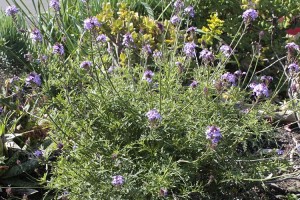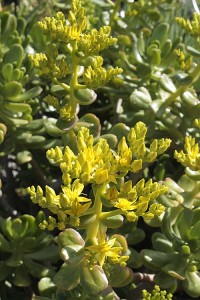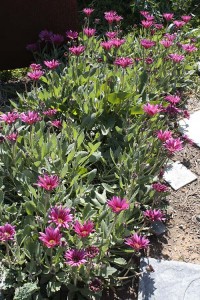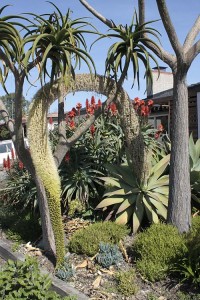I was looking at my blooming Agave attenuata and noticed something for the first time. The flowers on its spike have been opening asymmetrically, with the south-facing buds opening a few days earlier than the ones on the shaded side. I guess it’s the agave equivalent of moss growing on the shaded north side of a tree trunk. As I looked at all the agaves in the neighborhood, I was noticing the same thing: All the south-facing buds open first. It makes sense, I guess, with the sun-warmed buds developing sooner than the ones growing in the shade. There must be a botanical term for this–I’ll see if I can’t look it up sometime.
Something else I noticed the other week was that two of the little rosettes growing underneath the growth producing the big spike are also blooming. They’re nice, but the blooms get pretty lost in the foliage.
And compared to the big main spike, which must be something like twelve or more feet from base to tip, you can see how it’d be easy to overlook the little pups…
In the photo above you can make out this big red aloe in the background, Aloe arborescens. The clump began as a one-gallon plant in the early nineties. Now it’s probably six feet tall and twelve across.
February in Southern California is a busy month for flowering plants. Here’s a selection of what else is blooming in the garden.














As always, my thanks to Carol at May Dreams Gardens for hosting Garden Bloggers’ Bloom Day. Even with snow on the ground many places up north, there’s still plenty in bloom today in warmer, more southern locations, and on windowsills and greenhouses around the world. Check them out [ here ].






Hiya James.
High Summer, I call this.
Never mind February: looks more like August to me.
Freeway Daisies? Those precious, exotic Osteospermum which never quite make it in my garden?
Are you implying they grow untamed in road cracks?
Surely not.
That Carpenteria californica, I have always coveted it. Saw it in an open garden, but never found it for sale.
Don’t think it would survive a severe winter, do you know?
Thank you for sharing what will be summer blossoms here. It’s encouraging. I need freeway daisies along my driveway!
Happy Bloom Day.
Succulents are my weakness. It is like a disease. Thank you for sharing with us for Bloom Day!
We call them freeway daisies in central Cal too – and yes, they grow anywhere, like geraniums. Gosh such a lot blooming – definitely a month or more ahead of us up the coast. Lovely post. My pics from yesterday are all fuzzy. Maybe I’ll take a turn in the garden now before the sun gets high, try again…
Plants are fascinating, aren’t they. I wonder if the blooms on other plants do that too? I will have to check this summer.
James your fourth photo is amazing! What drama in your Agave attenuata … you have many beautiful blooms but this one steals the show for me! Striking!
Oh, how lovely to stroll through the blogosphere to a place where it’s ‘summer.’ I’m months away from snow melt. It’s freezing at my place. So, this tour through your garden was a great joy. Almost solved my cabin fever! :))Happy GBBD!
Wow! What a variety of blooming plants. Your post reminds me why I loved to garden in California when I was a child. How interesting about your agave flowers beginning on the south side…I will have to check to see if that is also happening on the flowering agave here in Arizona.
aloha,
what a celebration for bloom day, i love the detail information on the agave blooming to the sun, also love the carpenteria flower. what a nice collection you have blooming today. I enjoyed reading your beautiful post today:)
Love those agaves. I’ve got to find a way to get more of them into my landscape.
You have a ton blooming right now. I didn’t realize any of the solanums had scent. And I like that Carpenteria californica. Also interesting about the blooms and sun. Of course I’ve noticed my plants that get more sun bloom earlier, but I never thought about parts of the same plant or bloom stalk doing that.
Its nice to see someone with lots in flower
Wow! Your carpenteria is blooming? I always bite my nails whether mine makes it for Garden Tour day (April 18). Ah, well, there’s California, and there’s Southern California ;->
Happy bloom day
With this many flowers already, your blog should be called “February Dreams.”
Someday I hope to have the shade and the space to ateempt to grow a Carpenteria californica. They’re so beautiful, but I don’t think I have any appropriate spot to put one right now.
Joco, we call them informally “freeway daisies” because the transit department planted them in massive quantities on the sides of freeways. It’s been hard for the plant to attain any sort of respect as a result because they were so common. The carpenteria is listed as being reliably hardy to 10 degrees F. Depending on your climate, it might be an option for you.
Nell Jean, a big swath of freeway daisies next to the driveway would be perfect!
Katie, I’m slightly less smitten with succulents (probably temporarily) than when I first planted many of these in the early 90s. Still, even if they’re not my total infatuation right now, I still love them and what they do without demanding much water.
CM, I wonder if they planted the freeway daisies en masse up your way or whether the name just migrated north from Southern California. Etymology of common plant names would be an interesting project…
Melody, with plants, the more I look, the more I find. I agree with you–infinitely fascinating.
Carol, the agave isn’t just a little subtle poke of color, is it? Sixty-plus days into its bloom I’m still smitten.
Noelle, we’re definitely lucky in that we’re able to grow a huge number of plants without too much pampering, and often without too much in the way of added water.
Noel, thanks for visiting the subtropics! We can’t grow everything you can, but we make up for it with a few of our special plants.
Dorothy, the jury seems to be voting for the agave, along with you!
Brad, I hadn’t realized this plant was fragrant until this past week when I spent more time back on my slope garden and noticed this cloud of fragrance whenever I got close to it. I’d never noticed the scent out in the wilds.
Helen, this is about as flowerey as the garden gets, and helps make late winter, early spring my favorite time of year in the garden.
TM, yes, it’s blooming! In fact it started up at the end of January. If I recall correctly yours bloomed first last year. Go figure. Mine’s a young plant and spent a lot of last year growing. This year it seems to be more interested in things of the flesh, hence the flowers.
Gayle, it’s a load of flowers, all right, and I’m pretty excited right now. My own space for the carpenteria is just about the ugliest part of the garden, behind the veggie garden, next to a woodpile and rusted little shed. To visit the plant I need to wallow in ugliness. I probably won’t be showing any whole-plant photos of it for fear of scaring everybody with the plant’s location.
I try out at least one new site each Bloom Day. Yours is a real find: fabulous photography and a splash of sunshine for one from the soggy northcountry. Thanks!
Great shots, I love Oxalis unless it’s the weedy type sneaking thru my borders & lawn. So many lovely Arctosis cultivars out now in some really deep & interesting colors.
Tons of blooms, so very nice. I’d never heard that about agaves. I like those big giant aloes.
I really enjoyed seeing what you have blooming there, they’re all so different from what we have growing here. The main spike of the Agave is just amazing!
Lovely Carpenteria! Mine is nowhere near blooming – so it’s so nice to be reminded of ‘whats to come’….it’s truly one of my favorite natives!
Freeway daisies crack me up. And that Agave sure is taking its time, giving you lots of time to observe some cool stuff. February in the Southwest is a pretty special time.
Hi, James, I looked at your blog earlier today and was going to leave a comment for you, but didn’t have time at that point, so it was a nice surprise to see that you left a comment for me! I used to live in Southern California (Altadena) and I truly miss the year ’round gardening. I loved seeing your pictures that reminded me so much of California.
James – I have just one question for you and all the world? Why don’t we all live in California? WOW, the bounty of a February garden is mind boggling. Thanks for sharing – instead of hanging my head to cry, I’ll go sit by my fire and rest. For every thing there is a season – it will have to be my motto because I ain’t got a choice! Kelly
My goodness, that agave flower spike is a monster! Agaves here in CT are lucky to get over 2 feet! Thanks for sharing a glimpse of what we’re only dreaming about here in the land of snow! And thanks for visiting my blog 🙂
Wow! I’m so glad to know about your blog. Such an abundance in your garden, and your art is so evident in your site design. I particularly like the elegance of your banner at top. Thank you for visiting me at Gulf Coast Greenie.
Wow, that agave bloom is just massive! You have so many cool plants. Plants that I would love to grow. I keep stretching to grow some of them but this year I’m not sure if my agave is going to survive the freezes and snow so well.
Kate, nice that you could stop by and warm up a bit!
Ricki, thank you! We’ve had a few days of rain ourselves this winter, but it’s been sun sun sun for a few days now.
Susie, I agree that there are a lot of cool versions of arctotis that are coming on line. I find they mix really well with the California natives in their cultural requirements, even if they’re a little gaudier than most of the local plants. I read that the oaxlis I planted can be troublesome, though so far it’s nothing like the low monster oxalis that invades flowerbeds or the yellow Bermuda buttercup that’s all the scourge here near the coast.
Ryan, it’s definitely not hard to like these big red aloes, but I’m starting to worry if this one might be honing its designs to take over the front yard.
Catherine, each area does seem to have plants of a certain “look.” I think the species of areas like yours are pretty exotic-looking as well.
Rebecca, the carpenteria is only a couple years old, but it’s becoming one of my favorites as well.
Lynn, I suspect I’ll still have something agave related next month considering how slowly it’s moving to the end of its bloom stalk. But I think by that point it’ll be couched as an elegy…this great plant that took two decades to flower, bloomed for three months, and then died back to the ground…
Ruth, I spent a lot of my childhood years not too far from Altadena. It’s definitely one of the garden spots of the Los Angeles area.
Kelly, winter is great here, but our summer gardens are dry as toast, so you and much of the rest of the country will have way cooler things going on then!
GJ, I enjoyed my blog visit. It’s interesting what similar plants do in really different locations.
Martha, thank you! I enjoy working on the design of the blog almost as much as I enjoy working in the garden.
Jean, I hope your agave makes it! The species in my garden would turn into a popsicle if the temperatures dropped anywhere near what you’re going through right now.
Love the Astragalus nuttallii! What a sweet plant.
Thank you for sharing more pictures of your blooming attenuata…and the observation about the blooms opening differently on the sunny side. Isn’t nature interesting!?
‘Freeway daisies’?! Ouch! LOL
Hi James, thanks for visiting! You certainly have an amazing array of blooms. The difference in our winter climates is readily apparent…for example, I’ve never seen an aloe growing here;-) In VA right now we have several ft. of snow on the ground. Your Carpenteria Californica is lovely.
A lovely February flower garden!!